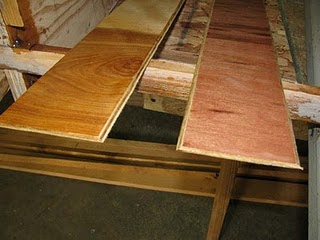 Here is How to cutting plywood with saw blades, When cross-cutting a plywood panel, the bottom layer of veneer often splinters out along the cut line. But there are steps you can take to prevent this.
Here is How to cutting plywood with saw blades, When cross-cutting a plywood panel, the bottom layer of veneer often splinters out along the cut line. But there are steps you can take to prevent this. Perhaps the easiest way to avoid splintering is to use a blade that's made just for cutting plywood. These blades have lots of teeth (typically 80), and the teeth are ground in a pattern that creates a clean, shearing cut.
But what if you don't want to spend the money for a single purpose, rarely used saw blade? There are a few tricks you can use to get a clean cut with a combination blade.
First, if the blade is crusted with sawdust or pitch, clean it before cutting the plywood. Sometimes, however, even a clean blade will splinter the veneer. There are two reasons for this. One is that a combination blade has fewer teeth than a plywood-cutting blade, so it doesn't cut as cleanly.
The other reason is that the cutting edge of the teeth may be pushing the veneer down rather than slicing it off.
One way to avoid this is to change the cutting angle of the teeth by raising or lowering the blade. If your panel is splintering on the bottom, lower the blade. If it's splintering on the top, raise the blade.
The most common way to get a clean cut is to score the panel along the cut line before making the cut. To do this, cut through the veneer layer with a sharp utility knife.
While this method works, it's sometimes difficult to line up the saw blade with the scored line. An easier way is to score the panel is to use the saw blade itself. The idea is to make the cut in two passes. On the first pass, set the blade just high enough to cut through the veneer layer. Then raise the blade to finish the cut on the second pass.
Another way to keep the veneer from splintering on the bottom is to use a backer board. This is a piece of plywood or Masonite that's placed below the workpiece when making the cut. This way the veneer layer is fully supported and the plywood can be cleanly cut.